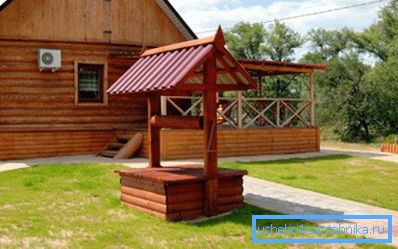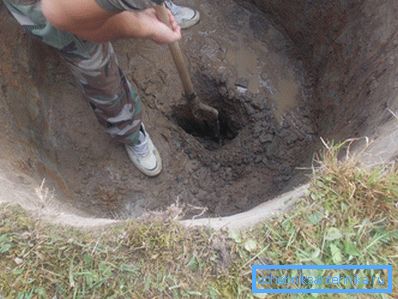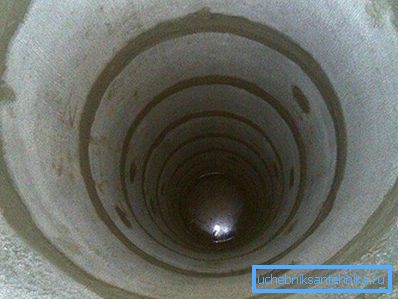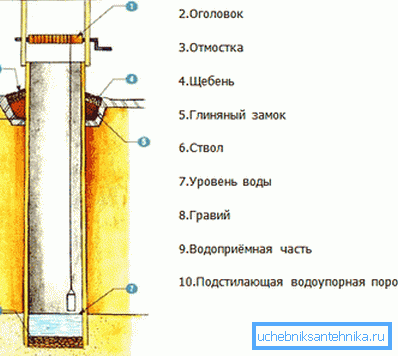What determines the depth of the well
To a rather frequent question, what should be the depth of the well, perhaps the most accurate answer would be that we should dig until the mine reaches a suitable aquifer. The thing is that there is no uniformity on the ground, so the depth of potable water is very different, moreover, there are usually several such layers, and they are at different depths, as geological exploration data can confirm.
Below we will talk about the presence of horizons, their structure and origin, ways of digging mines, and also see the thematic video in this article as an additional material.

Clean source
Note. Among the people, sometimes you can find such an expression as the artesian well, but there is no such thing. To achieve the artesian layer, wells are drilled, especially since such a layer is considered the property of the state and special permission is required for its operation.
Aquifers

- The concept of an aquifer or aquifer (from the English aquifer) does not imply a flow, but any sedimentary rocks that alternate between strata and they have different degrees of moisture permeability.. From under the ground, water penetrates through faults in rocks or through unconsolidated materials, such as sand, gravel, or clay, forming currents where it can be extracted using wells or deep wells.
- In addition to the deep, there are also surface horizons located much closer, so they are often used for both domestic and irrigation purposes.. In addition to the possibility of replenishing resources from underground streams, they are also replenished by natural precipitation, and the soil layer here serves as a filter.
- It should be noted that for measuring the capacity of wells (wells) there are two such concepts as dynamic and static level, which is calculated from the ground level to the mirror. At the same time, the static level is considered to be the filling of a well (well) when no water intake is made from it, and a dynamic one indicates the state when the water intake is made in full. It turns out that the last measurement is the most accurate, as it shows how quickly a well can fill up.

- Gravel deposits where groundwater is contained.
- Sands, which contains the aquifer pressure horizon.
- Moisture-permeable clay.
- Tectonic disruption.
- Gushing wells.
- Waterproof hard rocks and deposits.
- Groundwater. Level.
- Power up.
Note. In this section of the artesian basin, you see a site that is surrounded by mountains, which in itself creates favorable conditions for cleaning and preserving the hydronesus stream. There are rocks with reservoir properties (sand, gravel, pebbles), but along with them there are fractured rocks, for example, basalts or some loose rocks. The depth of such deposits is from 50 to 500m, and sometimes even more, therefore, they are not available for wells and here you can only drill wells.
Place for well

Note. If you decide to provide a house with water, but you live in a fairly polluted area, for example, near enterprises that evade creating high-quality sewage treatment plants (this happens very often), then how deep should a well be in order to have clean water ?! Therefore, it may turn out that drilling a well at least in sand (not artesian) will be much more prudent.
If you have decided to build, then you will have to decide how deep the well is to be dug, that is, find out how deep the suitable aquifer is, its capacity and quality. It is also necessary to find out the condition of the soil, which lies on hard rocks - loam, clay, sand, crushed stone, since there may not be enough water there and after a few years it will disappear.

On some soils, it is possible that the water appears after a few spade bayonets, but it is not suitable for drinking and, moreover, it needs to be cleaned, since it is not filtered precipitation.
Somewhat deeper, already at a depth of 3-5 meters, you can stumble upon a layer of solid clay that does not allow surface waters to go deep and does not give them to the surface - having broken it, you can get to the horizon; and such wells are called vertices. If such a structure is made in a zone remote from industrial enterprises, then it is very convenient - and not much to dig, and the price is low.
But top entry may turn out to be empty - as we have said, in the upper horizons the sources are less powerful, therefore, sometimes you have to skip such a layer and dig further, to the next horizon.
Of course, I would like to understand what the costs are before the start of work, but how to determine the depth of the well in advance?
To do this, there are several proven ways that you can use for budgeting and, in general, understand what you need - well, or well.
- The first method, and it is probably the simplest and most reliable, is the presence of one or another source from nearby neighbors - this usually works 100%, especially if there are several such neighbors. Here you can learn almost all the information, and the depth of occurrence, and purity, and taste, and even make a chemical analysis of water, taking it to the nearby sanitary epidemiological station.
- Another method to find out how deep to dig a well is to contact a hydrogeological survey and, most likely, they already have information on this site and you only have to pay a small amount for the certificate. But if such information is not available, then this service will be very expensive, then try to agree on this with your neighbors to make a contribution to the list - it will also be useful for them.
- But you can do without the services of hydrogeology, which means that you need to carry out test drilling of a well - this method will show you the depth at 100%, and you can make water samples in the laboratory. Of course, there will be a problem with the drill, but it can be rented privately. Again, this will allow you to find out the location of the aquifer, not only you, but also your neighbors.
Dig a well

So, you have decided on the place, learned how deep the water is, and now you, as SanPin 2.1.544-96 requires, will have to follow the necessary formalities so that later there will be no complications.
That is, you just need to find out about it in the local administration, but most likely, you will not need any documents, except for a certificate from the sanitary epidemiological station, since this is not an artesian well. There is also a possibility that no documents will be required from you at all.
From the tools you will need several shovels, buckets, a long rope, a long and short crowbar, as well as a winch, with which you will pull the buckets with the ground and the next worker from the mine.
This process is not technically difficult, but it is physically hard, and also carries a certain threat to life. That is, if the ground is soft, then the walls of the mine may collapse on the one who is inside - after that, not always have time to save a person!
But this is not an obstacle for professional diggers - simply, having dug one meter of soil in depth, the first concrete ring is lowered into the mine, thereby strengthening its walls.
Then the worker climbs into the middle and starts digging from the center to the walls of the ring, digging under them - the construction sags under its own weight, and then impose the next ring until the end of the work. This process is not fast, as the maximum depth of the mine can be up to 25, or even more meters!

The rings are made of heavy concrete, therefore, it is almost impossible to lower them into the mine without any adaptations and the simplest device for this is the winch that you see in the photo above. The number of rings, of course, will be determined by the depth of the mine plus the above-ground part, the height of which is usually no more than a meter.

In order to prevent surface groundwater from getting inside, you definitely need to seal all the seams with a cement-sand mortar, and where these joints will be under water, tar tar (cabal) will do. Also, be sure to seal the hole for the hose if you are going to equip an automatic pumping station, whether with a hydrophore or a submersible pump.
At the bottom of the well, a filter of gravel and gravel is arranged, and for this purpose it is best to use three different fractions.
It looks like this:
- a layer of 10–15 cm thick of the smallest rubble is poured on the bottom;
- then comes the second layer of the same thickness, but already the middle fraction;
- complete the filter cushion with gravel.

Another important part is the tip or the house, which protects the mine from falling there debris. Such a structure may be a cover and a roof with a collar for a well, but it may also be of a closed and even decorative type. A house for a well can also be made with your own hands, and not just as a protective structure, but as a beautiful element of your estate.
Conclusion
After the completion of the work, you may expect some disappointment, because the first water that you see in your source will be very dirty, but this is completely natural. Therefore, after filling the barrel to a statistical level, the water must be pumped out and done until you see clear, transparent water.